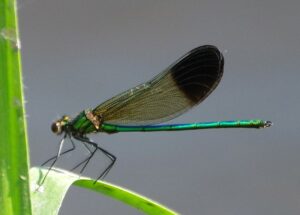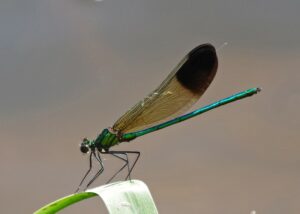Note: All links leave to external sites.
Greetings, BugFans,
The BugLady has seen a few River Jewelwings over the years, but this summer, one finally sat still long enough for her to get some pictures. River Jewelwings are not quite as spectacular as the more common Ebony Jewelwings, but they’re not shabby, either (one source calls them “sparkling.”).
The Jewelwings (there are two species in Wisconsin) and the Rubyspots (there’s one widespread species here plus a second that has a toe-hold in a single, far-southern county) are in the damselfly family Calopterygidae (which means “beautiful wing/beautiful feather” in Greek), the Broad-winged Damselflies.
Broad-winged damsels are large damselflies whose wings are proportionately wider for their length than those of damselflies like bluets, spreadwings, forktails, etc., and their wings aren’t attached to the thorax by “stalks” or “petioles”– the attachments are broad. Their body colors are metallic and iridescent, and their extra-long, extra-spiny legs help them snag insects on the fly (their aquatic naiads are pretty leggy, too). They’re the only damselflies that thermoregulate by “obelisking” (aiming the abdomen toward the sun to lessen the amount of its surface that’s receiving direct rays).
The Broad-winged damsels prefer flowing waters over still ones, and large numbers of Rubyspots and Jewelwings may congregate at the river’s edge during courtship.

RIVER JEWELWINGS (Calopteryx aequabilis) are found across our northern tier of states and well into Canada around clear rivers and streams whose shores are lined with trees that provide dappled sunlight and whose beds have plenty of submerged vegetation. They’re sensitive to pollution. They’re often found in the same bodies of water as Rubyspots, but the Rubyspots use the faster-flowing areas.
They’re about 2” long with wingspreads over 2”, and the outer third of each wing is dark. Females are similar to males (though some females have very pale wings), but the females’ wings have white pseudopterostigmas (OK – white spots) near the tips. Some males may look royal blue, which BugFan Freda says indicates that they have been eating well! They have a fluttery/skipping flight.
River Jewelwing naiads dine on fly larvae (including mosquitoes), mayfly naiads, freshwater shrimp, and other tiny critters that they find as they walk around on the river bottom. Adults grab insects like mayflies, mosquitoes, moths, and flying ants out of the air.
Like males of other kinds of Broad-winged damselflies, male River Jewelwings are territorial, patrolling stretches of shoreline, especially those that look like they would be good spots for females to oviposit. He uses those lovely wings both to defend his territory and in courtship. One source said that the Jewelwings are the only North American damselflies that perform a courtship display.
When a female approaches the water’s edge, a male courts avidly. He hovers in front of her with alternating fore and back-wing strokes displaying his wings like semaphore. He flutters, claps his wings together, and raises his abdomen, and he flies out, low over the water’s surface, as if to point out how good his territory is. After they mate, the female climbs down a plant stem and lays her eggs in soft plant tissue about a foot below the water’s surface, taking as long as a half-hour to do it, and then she floats or swims back up. Males do not accompany females into the water. The eggs will hatch in about three weeks, but the naiads will not mature for two or three years. When they’re ready to emerge, they crawl up onto plants on the shore. Groups of River Jewelwings may roost together on a river bank in the evening.
One source said that “They are skittish & difficult to approach while wading …” a sentence that the BugLady’s awesome freshman English (and grammar) teacher, Miss Broetzman, would not have liked (the BugLady can see her red pencil – “vague reference”). Snarkiness aside, the BugLady was amazed to see, in bugguide.net’s collection of images, pictures of Jewelwings perched on people’s fingers, because they are, indeed, skittish, and the BugLady seldom gets closer to one than about 6 feet.
The BugLady recommends this nice, downloadable reference that she sometimes comes across in her research.
The BugLady
